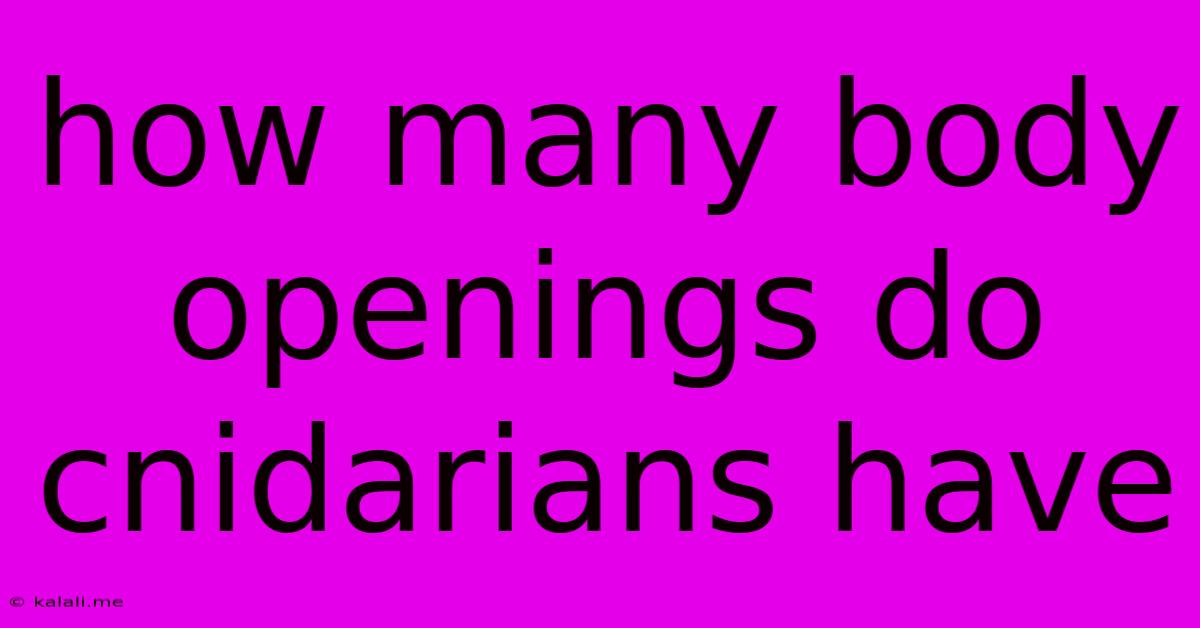How Many Body Openings Do Cnidarians Have
Kalali
May 09, 2025 · 3 min read

Table of Contents
How Many Body Openings Do Cnidarians Have? A Dive into Cnidarian Anatomy
Cnidarians, a fascinating phylum encompassing jellyfish, corals, sea anemones, and hydras, possess a unique body plan that sets them apart from other animal groups. Understanding their anatomy, particularly the number of body openings, is key to appreciating their evolutionary significance and ecological roles. This article will explore the digestive system of cnidarians and answer the question: how many body openings do they have?
The Simple Digestive System of Cnidarians
Unlike more complex animals with separate mouths and anuses, cnidarians only have one body opening. This single opening, often called the mouth, serves a dual purpose: it's both the entry point for food and the exit point for waste. This means that digestion occurs within a gastrovascular cavity, a sac-like space where both ingestion and egestion take place.
The Gastrovascular Cavity: A Multi-tasking Organ
The gastrovascular cavity is far more than just a simple digestive chamber. It plays a vital role in several critical functions:
- Digestion: Enzymes secreted into the cavity break down ingested food. Nutrients are then absorbed directly through the gastrodermal cells lining the cavity.
- Circulation: The gastrovascular cavity facilitates the distribution of nutrients throughout the body. Because cnidarians lack a circulatory system, this cavity serves as a rudimentary circulatory system.
- Gas Exchange: The thin walls of the gastrovascular cavity allow for the exchange of gases (oxygen and carbon dioxide) directly with the surrounding water.
- Hydrostatic Skeleton: In some cnidarians, the fluid within the gastrovascular cavity acts as a hydrostatic skeleton, providing structural support and aiding in locomotion.
Variations in Gastrovascular Cavity Structure
While all cnidarians share the basic plan of a single opening and a gastrovascular cavity, there are variations in its complexity depending on the species and body plan. For instance, some cnidarians have a relatively simple, sac-like cavity, while others have more complex structures with branching canals that extend throughout their bodies. These variations reflect adaptations to different lifestyles and feeding strategies.
Implications of a Single Body Opening
The presence of only one body opening has significant implications for cnidarian biology:
- Limited Digestive Capacity: Because food and waste share the same entry and exit point, cnidarians are generally limited in the size and type of prey they can consume. They rely on extracellular digestion, breaking down food within the gastrovascular cavity before absorbing nutrients.
- Efficiency in Simple Environments: The simple digestive system is well-suited to the environments cnidarians inhabit. In many cases, food is relatively abundant and easily digestible.
- Evolutionary Significance: The simple body plan, with its single opening, represents a crucial stage in the evolution of more complex animals with complete digestive tracts.
Conclusion: One Opening, Many Functions
In conclusion, cnidarians possess only one body opening, which serves as both a mouth and an anus. This single opening connects to a gastrovascular cavity that performs multiple essential functions, including digestion, circulation, gas exchange, and even structural support. While seemingly simple, this unique anatomical feature is a testament to the remarkable adaptability and evolutionary success of this diverse and fascinating group of animals.
Latest Posts
Latest Posts
-
Jaguar Adaptations In The Tropical Rainforest
May 10, 2025
-
How To Find Average Velocity From Velocity Time Graph
May 10, 2025
-
What Is Non Living Things In The Ecosystem
May 10, 2025
-
How Many Fl Oz In 6 Cups
May 10, 2025
-
What Is 1 Percent Of 5000
May 10, 2025
Related Post
Thank you for visiting our website which covers about How Many Body Openings Do Cnidarians Have . We hope the information provided has been useful to you. Feel free to contact us if you have any questions or need further assistance. See you next time and don't miss to bookmark.